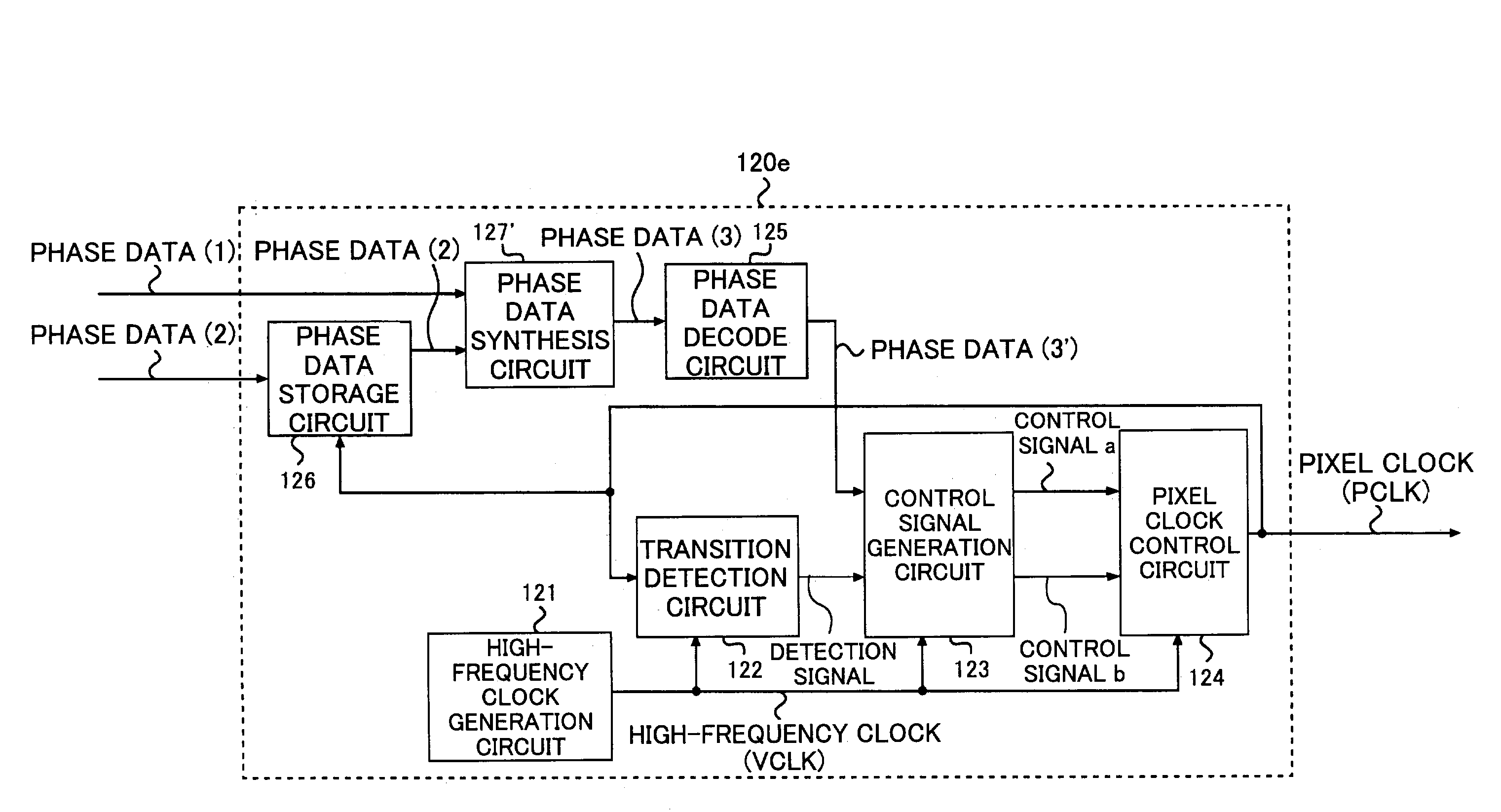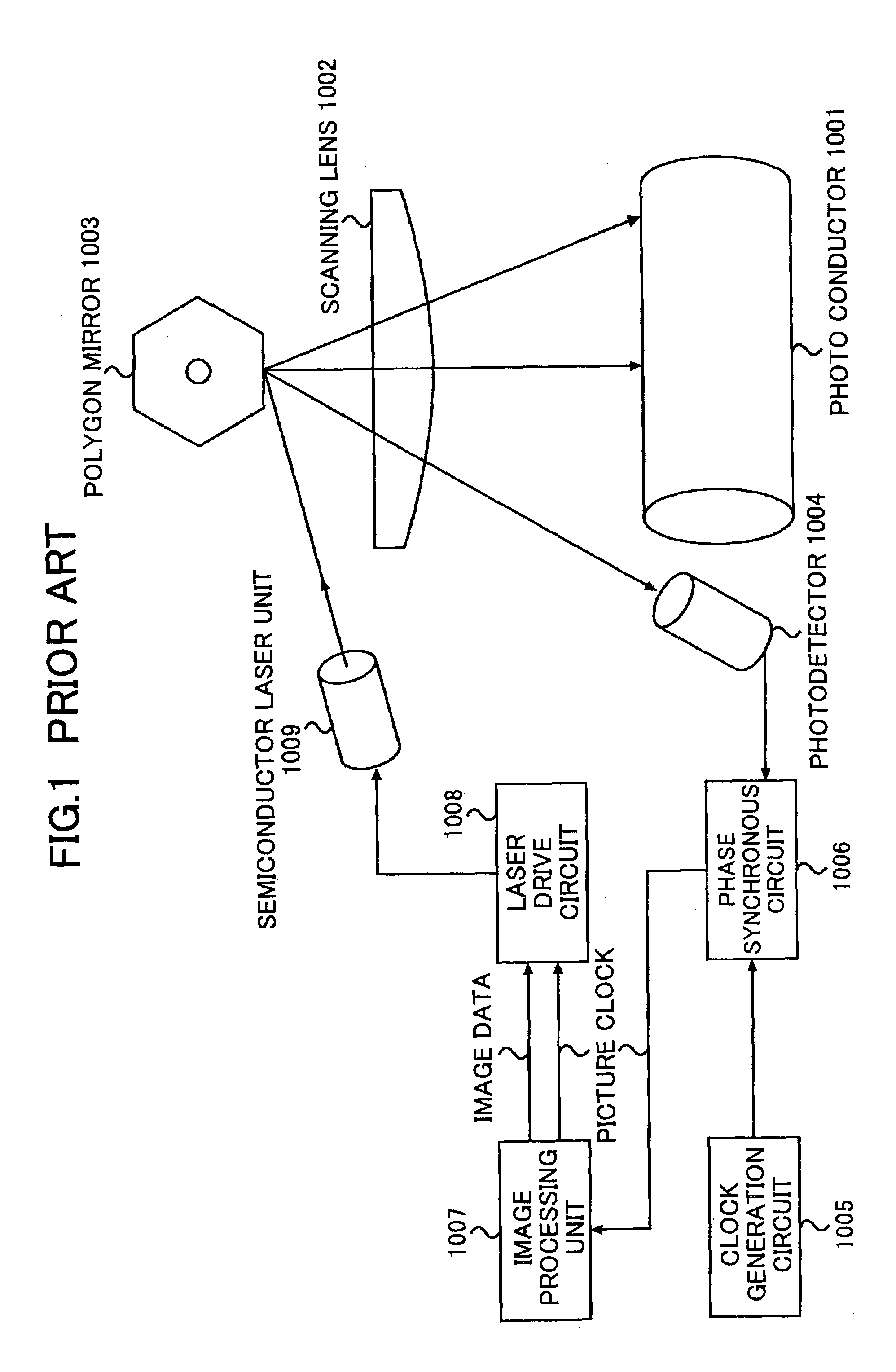Pixel clock generation device causing state transition of pixel clock according to detected state transition and phase data indicating phase shift amount
a generation device and state transition technology, applied in the direction of visual presentation, instruments, printing, etc., can solve the problems of irregular scanning speed of optical spots (i.e., scanning beams) on scanned surfaces, deterioration of image quality, and difference in scanning width of optical spots corresponding to respective light-emitting sources on scanned mediums
- Summary
- Abstract
- Description
- Claims
- Application Information
AI Technical Summary
Benefits of technology
Problems solved by technology
Method used
Image
Examples
embodiment 1
OPERATION OF EMBODIMENT 1
[0081]Next, a description will be given, with reference to a timing chart of FIG. 7, of operations of the pixel clock generation part 120. FIG. 7 shows examples of respective cases where phase shift amounts are ‘0’, ‘−1’ and ‘+1’. Besides, Table 2 below shows correspondences between the phase shift amounts and the phase data.
[0082]
TABLE 2Phase shift amountPhase data0 (no phase shift)011Advance 1 / 8 PCLK100Advance 2 / 8 PCLK101Advance 3 / 8 PCLK110Delay 1 / 8 PCLK010Delay 2 / 8 PCLK001Delay 3 / 8 PCLK000
[0083]Phase Shift Amount=0
[0084]First, a description will be given of the case of generating the pixel clock (PCLK) with the phase shift amount being ‘0’. In this case, the phase data “3” is supplied to the control signal generation circuit 123 at a timing t1 synchronous with a rise of the pixel clock (PCLK). At the same timing t1, the rise of the pixel clock (PCLK) is detected by the transition detection circuit 122 so that a detection signal is generated, and is suppli...
embodiment 2
[0099]Next, a description will be given of another structure of the pixel clock generation part 120 according to the foregoing first embodiment as a second embodiment according to the present invention. FIG. 8 is a block diagram showing the structure of a pixel clock generation part 120a according to the present second embodiment.
[0100]As shown in FIG. 8, the pixel clock generation part 120a further comprises a phase data decode circuit 125 in addition to the structure of the pixel clock generation part 120 according to the foregoing first embodiment. This phase data decode circuit 125 converts phase data (1) from outside (for example, the dot displacement detection / control part 110 shown in FIG. 2) into phase data (1′) inside the pixel clock generation part 120a. In the present embodiment, it is assumed that the phase shift amounts and the phase data (1) outside have correspondences as shown in Table 3 below.
[0101]
TABLE 3Phase shift amountPhase data (1)0 (no phase shift)000Advance ...
embodiment 3
[0106]Next, a description will be given of another structure of the pixel clock generation part 120 according to the foregoing first embodiment as a third embodiment according to the present invention. FIG. 9 is a block diagram showing the structure of a pixel clock generation part 120b according to the present third embodiment.
[0107]As shown in FIG. 9, the pixel clock generation part 120b further comprises a phase data storage circuit 126 for storing a plurality of phase data, in addition to the structure of the pixel clock generation part 120 according to the foregoing first embodiment. A plurality of phase data are preset in this phase data storage circuit 126 from outside and so forth. Accordingly, upon operation, the phase data storage circuit 126 reads the phase data one by one in synchronization with the pixel clock (PCLK), and supplies the phase data to the control signal generation circuit 123. Besides, the phase data storage circuit 126 includes an address counter.
[0108]As...
PUM
 Login to View More
Login to View More Abstract
Description
Claims
Application Information
 Login to View More
Login to View More - R&D
- Intellectual Property
- Life Sciences
- Materials
- Tech Scout
- Unparalleled Data Quality
- Higher Quality Content
- 60% Fewer Hallucinations
Browse by: Latest US Patents, China's latest patents, Technical Efficacy Thesaurus, Application Domain, Technology Topic, Popular Technical Reports.
© 2025 PatSnap. All rights reserved.Legal|Privacy policy|Modern Slavery Act Transparency Statement|Sitemap|About US| Contact US: help@patsnap.com



